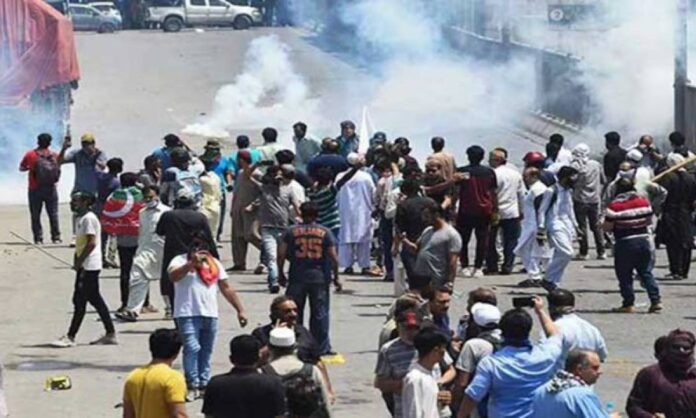The tragic events of May 9 have rendered Pakistan a global menace
The May 9 tragic events and the ensuing developments around it once again brought the international spotlight on Pakistan and its chequered hybrid politics — which currently is overflowing with loyal-than-the-king narratives — all focused on a cornered opponent. Imran Khan himself signed off his political death warrants, runs the argument. Yes, he committed multiple tactical mistakes and surrounded himself with a number of self-serving people who led him down a disastrous path. But the former prime minister cannot absolve himself of the responsibility of many things that went bad. But let us not delude ourselves. Many of those “bad things” were only reflective of a culture based on a tardy and elitist model of governance — the One Percent Republic in the words of former finance minister Miftah Ismail. And that is a metaphor for our civil-military elites, most of whom keep switching loyalties. And the mantra always flows from their concern for “rampant corruption”. Cumulatively, this approach has resulted in a system that reeks from contradictions and hypocrisy of the key stakeholders. And this prevents qualitative change in the country’s politics.
Why this postulation? On June 2, The Economist tweeted its story on Pakistan’s current political turbulence with the following caption
…..@TheEconomist
Pakistan has become a global menace. It is abysmally governed, violent, unstable and nuclear-armed. https://econ.st/3C4QLar.
No citizen likes to hear such painful description of his/her country because of the sense of belonging. But it was nothing new. It reminded me of former US Secretary of State Madeleine Albright. She made two similarly strong references to Pakistan in December 2008 and early 2013.
“…my own sense is Pakistan has everything that gives you an international migraine. It has nuclear weapons, it has terrorism, extremists, corruption, very poor and it’s in a location that’s really, really important to us. And now with this issue with India,” the late Alrbright had said in a press talk in Washington.
“And I also do think that the next president and the secretary of state are going to have to pay a great deal of attention to that combination of issues, Pakistan, India and Afghanistan, that all fit together. That’s very important to the United States,” she added.
Later in January 2013, Ms Alrbright reiterated her views in a lecture at New Delhi.
“Pakistan continues to be an international migraine. It has poverty, extremism, issues of nuclear non-proliferation and a weak government. It needs to learn how to deal with extremism and the issue of nuclear non-proliferation. It is central to many problems,” she said, adding in a lighter vein that that can resolve the “migraine”.
The former foreign secretary essentially listed problems that the US and India believe represent threats not only to Pakistan itself but also to the world around it.
On the occasion she also made a candid reference to Kashmir expressed her criticism of the United Nations.
“My father was a Czechoslovakian diplomat and was working in the UN. He was on the panel on Jammu and Kashmir. I am getting older, but the Kashmir issue is still not resolved,” she said in a lighter vein.
In October 2022, President Joe Biden articulated those concerns on Pakistan like never before.
“This (President Xi) is a guy who understands what he wants but has an enormous, enormous array of problems. How do we handle that? How do we handle that relative to what’s going on in Russia? And what I think is maybe one of the most dangerous nations in the world: Pakistan. Nuclear weapons without any cohesion,” Biden said at a reception of the Democratic Congressional Campaign Committee on October 13. In his speech he also touched upon the war in Ukraine, China and domestic issues and called Pakistan “one of the most dangerous nations in the world.”
What makes Pakistan a dangerous nation in the eyes of foreign leaders? Mismanagement, absence of a vision for a better future for the tens of millions living here, refusal of the one per cent to reforms needed for economic revival and socio-political cohesion? Or just the nuclear programme that our elites tout as the “invincible shield” against any aggression?
The IMF delivered an unprecedented, stinging press statement (on May 30) to illustrate Pakistan’s problems:
“We take note of recent political developments, and while we do not comment on domestic politics, we do hope that a peaceful way forward is found in line with the Constitution and the rule of law … Overcoming the present economic and financial challenges would require sustained policy efforts and reforms for Pakistan to regain strong and inclusive private-led growth. Strengthening domestic revenue mobilization and eliminating state owned enterprises (SOE) losses to create fiscal space are also critical for ongoing sustainability, reducing inefficiencies which affect the private sector, and allowing a scaling up of social and development spending.”
Let us be clear; the view from abroad on Pakistan has only worsened since Madeline Albright’s “migraine” comment in 2008. Events since the change of government in April 2022 have only reinforced those perceptions. Provisional “management and engineering” will not help improve those perceptions.
The article originally appeared in The Express Tribune




